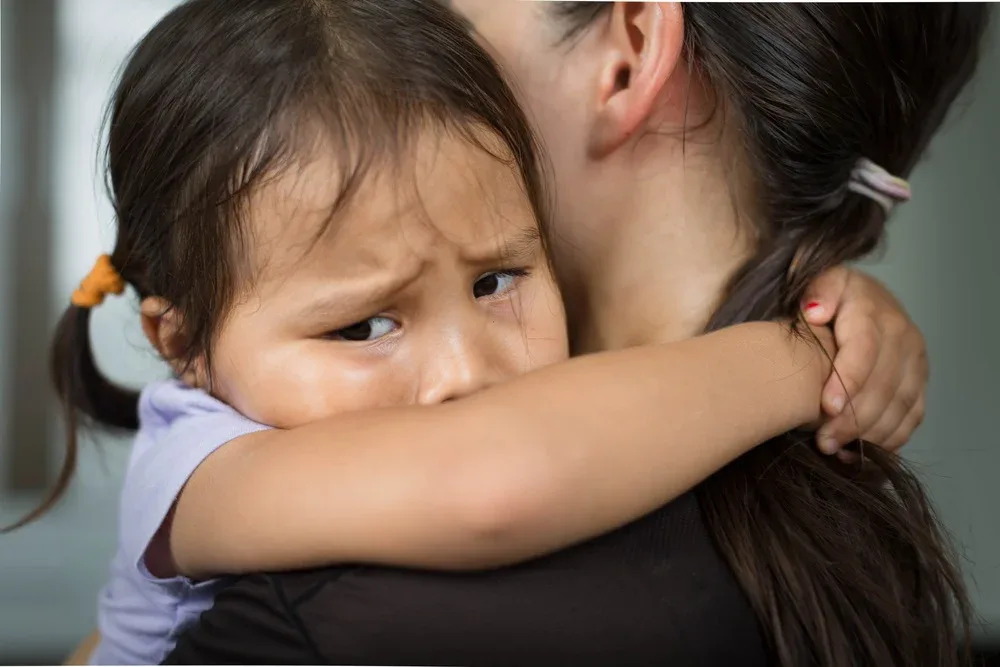
Separation anxiety is a prevalent issue among young children, particularly as they face major changes like starting daycare. It manifests as distress and apprehension when children are separated from their parents or primary caregivers.
Understanding and effectively managing separation anxiety is essential for ensuring a smooth transition into daycare, promoting emotional resilience, and supporting overall development. This comprehensive guide offers practical strategies and insights to help children and parents navigate this challenging phase more easily and confidently.
Contents
- 1 What is Separation Anxiety?
- 2 Signs of Separation Anxiety in Children
- 3 Managing Separation Anxiety: Preparing Your Child for Daycare
- 4 Techniques to Ease Separation Anxiety
- 5 When to Seek Professional Help
- 6 What’s the Best Age to Start Daycare?
- 7 Signs Your Child Is Ready For Daycare
- 8 FAQs
- 8.1 What age is normal for separation anxiety to start?
- 8.2 How long does separation anxiety last?
- 8.3 Can I visit my child at daycare if they are struggling with anxiety?
- 8.4 How can I tell if my child's separation anxiety is more severe than normal?
- 8.5 Are there activities at home that can help reduce separation anxiety?
- 9 Conclusion
What is Separation Anxiety?
Separation anxiety is a developmental stage during which children experience fear and anxiety when apart from their primary caregivers. It is a normal part of childhood development, typically emerging around eight months old and sometimes lasting through preschool.
This condition reflects children’s strong bond with their parents, demonstrating their understanding of close relationships and the anxiety that comes with the temporary loss of those bonds.
Signs of Separation Anxiety in Children
Identifying the signs of separation anxiety early on is vital in taking appropriate steps to manage it. Symptoms can vary widely but often include persistent crying when a parent leaves excessive clinginess, and reluctance to engage with others or participate in activities without their parent nearby.
Physical symptoms like stomachaches, headaches, or even vomiting can occur when faced with the prospect of separation. Understanding these signs helps in tailoring approaches
Managing Separation Anxiety: Preparing Your Child for Daycare
Preparing your child for daycare is essential to ensure their smooth transition into a structured learning environment. As parents, guardians, or caregivers, it’s natural to feel excitement and apprehension about this new chapter in your child’s life.
However, with thoughtful preparation and proactive measures, you can help your little one feel confident, secure, and ready to start this enriching journey of growth and development.
Start with Short Separations
To mitigate the impact of separation anxiety, begin by introducing your child to the concept of short separations. This can be done by arranging times where the child stays with other trusted family members or friends for brief periods.
These experiences help the child learn that separations are temporary and that their caregivers will return. Increasing the duration of these separations will further ease the transition into a full-day daycare environment.
Develop a Goodbye Ritual
A consistent goodbye ritual can significantly ease separation anxiety. This could be a special handshake, a goodbye kiss, a wave through the window, or a reassuring phrase. Rituals like these help provide a sense of predictability and comfort, making the separation process smoother for both child and parent. Over time, these rituals can become a reassuring part of the child’s routine, reducing anxiety at the point of separation.
Talk About Daycare Positively
Prepare your child for daycare by discussing it in a positive light. Highlight the exciting aspects, such as making new friends, engaging in play, and participating in various fun activities. This builds a sense of anticipation and curiosity about daycare rather than fear.
Reading books about daycare, discussing what to expect, and visiting the daycare together before starting can help your child become more comfortable with the new environment.
Techniques to Ease Separation Anxiety
Separation anxiety is a feeling that many people, including children and adults, may experience. It can be difficult to deal with emotionally. This feeling can occur when you say goodbye to someone you care about, leave a familiar place, or change your daily routine.
You may feel nervous and upset, but there are ways to feel more calm and secure during these times. By learning about what causes separation anxiety and using helpful methods, you can feel better and more able to deal with these feelings. This can help you become stronger and better able to handle difficult situations in the future.
Consistent Drop-off Routine
Establishing a consistent drop-off routine can play a crucial role in alleviating separation anxiety. Keep the routine quick and upbeat to set a positive tone for the day. Consistent routines can reduce the unpredictability that fuels anxiety, providing the child with a secure sense of what to expect each day. This routine might include familiar steps like unpacking their bag together, giving a quick hug, and saying a cheerful goodbye.
Leave a Comfort Object
Allowing the child to bring a comfort object from home, such as a favorite toy, blanket, or even a family picture, can make a big difference. These items are a tangible connection to home, offering comfort and reassurance throughout the day. They can help the child feel safer and more secure in the new environment, making the transition smoother and less stressful.
Stay Calm and Reassuring at Separation
Parents must manage their own emotions during separations. Children are highly perceptive and can pick up on their parents’ anxieties, which can, in turn, heighten their own. By remaining calm, composed, and reassuring during the separation, parents can model positive behavior, encouraging children to feel secure and supported as they adapt to their new environment.
Choose the Right Daycare
Choosing a daycare that fits your child’s temperament and needs can greatly influence their ability to adapt. Look for a facility that provides a nurturing, supportive environment and where the staff are experienced in dealing with separation anxiety.
Visiting several daycares, observing how the caregivers interact with the children, and checking the environment for comfort and safety are all important steps in selecting the right daycare.
Communicate Your Child’s Needs
Effective communication with daycare staff about your child’s specific needs and comfort strategies can enhance the care they receive. Inform the caregivers about your child’s likes and dislikes, what soothes them, and particular fears or triggers. This information can empower the caregivers to provide more personalized care, which can help ease the child’s anxiety.
Stay Involved with the Daycare Activities
Staying involved in your child’s daycare activities can reassure your child of your support and interest. Attend open days, participate in events, and regularly communicate with the caregivers. This involvement shows your child that you value their new environment and are part of their world, even when you are not physically present.
When to Seek Professional Help
It is important to know when to get help from a mental health professional to take care of your mental and emotional well-being. Sometimes, it can be hard to deal with the stress and challenges of life, and you might feel that you need someone to talk to. A mental health professional can help you understand your feelings and provide you with tools to cope with them.
Persistent Anxiety
While it’s normal for children to experience some degree of separation anxiety, it should gradually decrease as they get used to the new routine. Suppose the anxiety persists for an extended period or worsens. In that case, it may be necessary to consult a pediatrician or a child psychologist. These professionals can offer guidance and support, providing strategies or interventions to help your child cope more effectively.
Impact on Child’s Daily Life
If separation anxiety significantly interferes with your child’s daily activities or overall happiness, seeking professional advice is crucial. Persistent distress can affect a child’s emotional and social development and might indicate deeper anxiety issues. A healthcare professional can assess the situation and, if necessary, suggest appropriate therapeutic approaches.
What’s the Best Age to Start Daycare?
When deciding when to send a child to daycare, there are many things to consider. This includes things like how the child is developing and what the family needs. People have different opinions on the best age for a child to start daycare.
Some say it’s good for them to socialize with other kids and learn early on, while others think it’s better to wait. Overall, it’s an important decision that requires careful consideration of many factors affecting a child’s early years. Learn more:
What’s the Best Age to Start Daycare?
Signs Your Child Is Ready For Daycare
When parents decide to enroll their child in daycare, it is a big step for both parents and children. It is a new period with many opportunities for growth, learning, and socializing. However, knowing if your child is ready for this change can be difficult.
By paying attention to specific signs and behaviors, you can understand whether your child is prepared for daycare. Learn more:
Signs Your Child Is Ready For Daycare
FAQs
What age is normal for separation anxiety to start?
Separation anxiety typically begins around eight months of age and can persist into the preschool years. However, the intensity and duration can vary significantly among children.
How long does separation anxiety last?
The duration of separation anxiety varies. While most children outgrow it by age three, some may experience it longer, especially if they face frequent or particularly stressful separations.
Can I visit my child at daycare if they are struggling with anxiety?
Yes, many daycares allow parents to visit during the day. This can reassure your child and reduce their anxiety about being away from you.
How can I tell if my child's separation anxiety is more severe than normal?
If separation anxiety is severe enough to interfere with daily activities, persists beyond the typical age range, or is accompanied by extreme distress, it may be more severe than usual. In such cases, consulting a professional is advisable.
Are there activities at home that can help reduce separation anxiety?
Engaging in role-playing games that involve separations, like playing school or daycare at home, can help. Also, practicing brief separations, like leaving the child with another caregiver for short periods, can gradually desensitize them to the anxiety of separation.
Conclusion
Starting daycare is a significant milestone in a child’s life. It can be challenging due to the onset of separation anxiety. By understanding the nature of this anxiety and implementing effective strategies, parents can help their children overcome their fears. Patience, persistence, and supportive techniques can ensure that this transition is as smooth as possible. Remember, seeking help is okay if managing this stage overwhelms you or your child.
If you’re looking for a nurturing environment where your child can thrive and overcome separation anxiety with the support of experienced caregivers, consider DeeCyDa Daycare. Our daycare starters program is designed to ease the transition for both children and parents, providing a supportive and enriching environment for your child’s growth and development.

